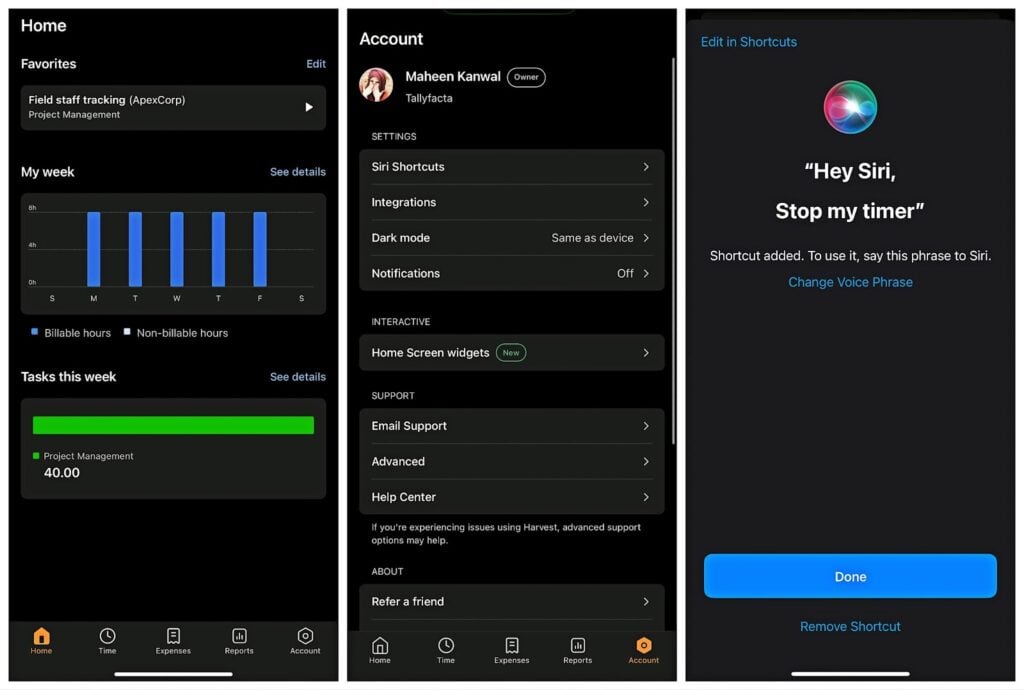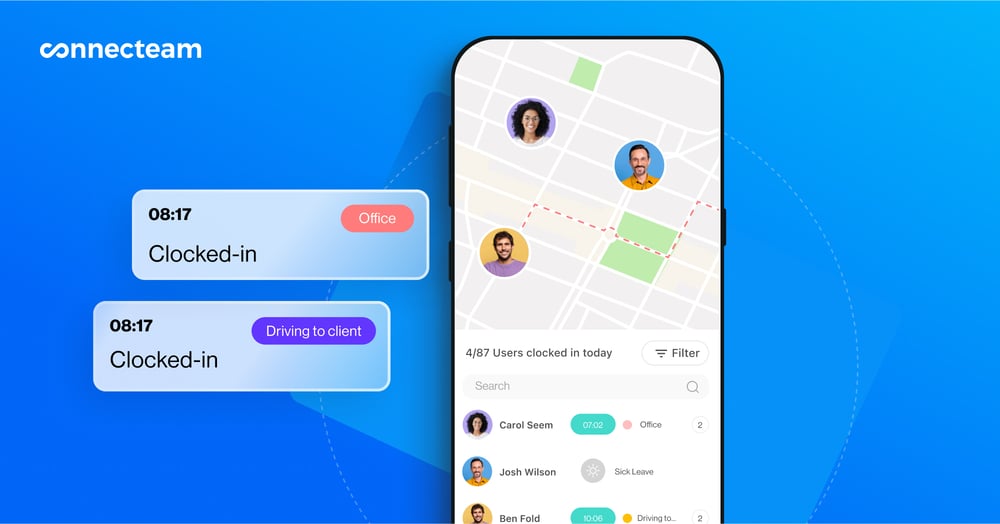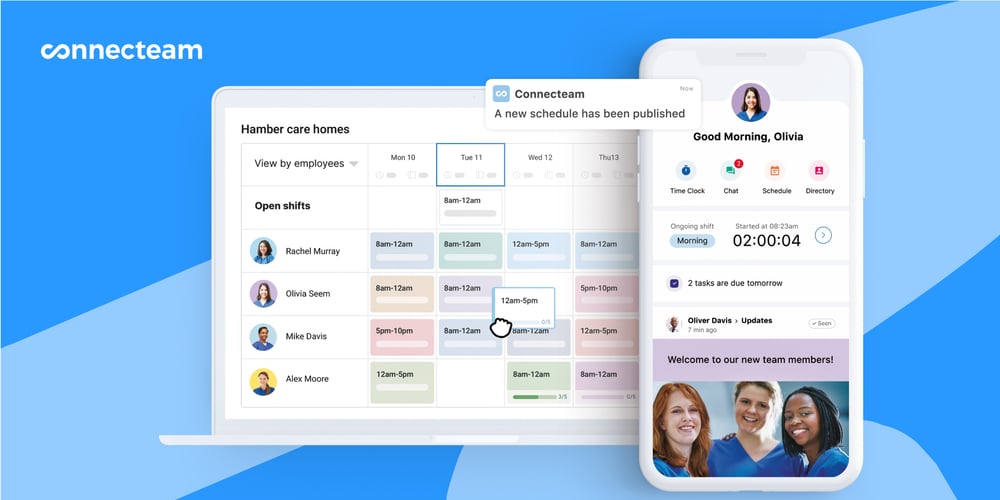Hubstaff and Harvest are both time tracking tools. One is better for overseeing remote and mobile teams, while the other might be a good fit for project and client-focused needs. Learn more in my review.
Hubstaff and Harvest let you track your workers’ hours, manage projects, and see reports, but they work in different ways. Whether you’re working alone or managing a team, it’s important to choose the right tool for your needs.
In this article, I compare Hubstaff and Harvest to help you decide which one is the better fit for you and your business.
A note about our method: All product comparisons and verdicts in this guide are based on hands-on testing by our expert team. All screenshots are original and were taken during actual tests.
At a Glance: Quick Summary
Hubstaff offers several useful features, including GPS-based time tracking, overtime logging, and user-friendly mobile and desktop apps. It’s ideal for mobile or field teams. However, I discovered that its geofencing isn’t very reliable, as it allows employees to clock in outside job sites, and it lacks shift or biometric tracking.
Harvest, on the other hand, has a clean interface, built-in invoicing, and over 50 integrations. It’s great for freelancers and small teams but may feel too basic for larger companies. However, I think Harvest’s per-user cost adds up, while Hubstaff is more affordable annually.
Overall, Hubstaff is better for tracking physical teams, while Harvest suits digital project workflows.
Pricing and Plans
Let’s break down and compare the pricing plans of Hubstaff and Harvest to see which tool gives you the best value for your money.
| Plan | Hubstaff | Plan | Harvest |
|---|---|---|---|
Free | ❌ | Free | Free for life for 1 user and 2 projects Includes: Time tracking Reminders Budgeting Invoicing Payments Cost and expense tracking Reporting and analytics 50+ integrations |
Starter | $7/user/month Includes: Time tracking Timesheets Activity levels Limited screenshots Limited app & URL tracking Limited reports Limited payments Clients & Invoices | — | — |
Grow | $9/user/month Includes everything in Starter, plus: Reports 1 integration Idle timeout Project budgets Work breaks Expenses | Pro | $11/user/month Includes everything in Free, plus: As big a team as you need Unlimited projects Team reporting Accounting and payment integrations Scheduled phone support |
Team | $12/user/month Includes everything in Grow, plus: Team management Payments & payroll processing Unlimited screenshots Unlimited app & URL tracking Unlimited integrations Idle time tracking Overtime calculation Time off management Timesheet approvals Scheduling & attendance Client budget management | Premium | $14/user/month Includes everything in Pro, plus: Profitability reporting Timesheet approvals Activity log Custom reports and exports SAML-based SSO Require notes Custom onboarding support for 50+ seats |
| Enterprise | Custom—billed annually only | — | ❌ |
| *Pricing is per month when billed annually. | |||
Harvest gives you a free plan if you’re solo, but paid plans start at $11/user/month.
Hubstaff doesn’t have a free tier, but its pricing starts lower, at $7/user/month. I like that Hubstaff also packs in more productivity and employee monitoring tools early on. Meanwhile, Harvest focuses on time tracking, invoicing, and project budgeting.
For $12/user/month, Hubstaff gives you access to scheduling, timesheet approval, screenshots and productivity monitoring, budgeting, and other tools. Harvest starts to offer some of these features in its Premium package at $14/user/month.
Ultimately, Hubstaff seems a bit more affordable.
Pros and Cons
Hubstaff pros ✅
- The desktop app is intuitive and makes it easy for admins to track employee hours, activity levels, app and URL usage, and optional screenshots in real time.
- The time tracker lets you log hours with a single click. It captures active time, idle time, and breaks automatically, giving accurate, hassle-free reports.
Hubstaff cons ❌
- Many of Hubstaff’s features, such as activity tracking and screenshot capturing, work on the desktop version only and are targeted towards desk-based rather than field teams.
- Unlike with a proper workforce management tool, you can’t schedule shifts tied to specific projects or geographic locations.
Harvest pros ✅
- You can generate professional invoices directly from tracked time and expenses and send them to clients via email, making billing fast, easy, and accurate.
- It offers over 50 native integrations, ranging from project management tools like Asana and Trello to accounting platforms like QuickBooks.
Harvest cons ❌
- Harvest’s per-user pricing can add up quickly, making it a costly choice for larger teams.
- Harvest may feel too basic for larger enterprises or teams with complex project management needs, as it lacks advanced features like task dependencies or detailed resource planning.
Use Cases
Hubstaff is best for:
- Keeping track of what remote teams are working on: It records activity levels, takes optional screenshots, and logs which apps and websites are being used.
- Client billing: By linking tracked time to specific projects and tasks, it makes it easy to generate detailed, billable timesheets and invoices that reflect exactly how time was spent.
Harvest is best for:
- Time tracking for client projects: It lets teams log hours against specific tasks, monitor budgets in real time, and turn those tracked hours into professional invoices with just a few clicks.
- Analyzing team capacity and performance: Its built-in reports show who’s overbooked, underutilized, or burning too many hours on specific projects, helping managers make smarter resourcing decisions.
Side-by-Side Feature Overview
Below is a side-by-side breakdown of Hubstaff and Harvest’s key features, with an emphasis on the tools that matter most for managing mobile, deskless workforces.
Time tracking and location enforcement – Winner: Hubstaff
Both Hubstaff and Harvest offer solid time tracking, but they serve different needs.
Hubstaff gives you more control via numerous platforms. Employees can track time via desktop, mobile, web, or a Chrome extension, and managers can set policies for which app is allowed. It supports both manual and automatic tracking, with an offline mode included.
What I particularly like are Hubstaff’s GPS and geofencing features. Geofencing features mark a particular area as the job site and enable the timer to start or stop automatically when someone enters or leaves the job site. You can also enforce clock-in rules, use photo punches, and prevent timesheet edits, making it ideal for field teams or businesses needing tight time controls.

Hubstaff also offers break tracking with alerts and lets you create rules for paid and unpaid breaks. However, I think its overtime tracking could be better. It allows for weekly limits only and can’t handle both overtime and double-time policies at once, which may be limiting for compliance-heavy industries.
Harvest, in contrast, keeps things simple. You can track time manually or with a timer, assign tracked time to specific projects, and view it all in a clean weekly layout.
However, it lacks GPS, geofencing, and overtime alerts, essential tools to manage field-based and mobile teams. While timesheets can be submitted for approval, managers can’t directly edit them.
All this considered, Harvest is perfect for agencies or freelancers who want straightforward, accurate time tracking without extra layers. But my overall vote goes to Hubstaff because its time-tracking features are best suited for deskless or mobile workers.
Employee scheduling – Winner: Hubstaff
When it comes to employee scheduling, Hubstaff stands out.
It offers built-in scheduling features where managers can assign shifts, set work hours, and define clock-in times. You can restrict when employees can track time and get notified if someone misses a shift or logs time outside of scheduled hours.
Hubstaff also provides detailed visibility into what employees are working on, but these features are more useful for desk-based teams rather than field teams.

On the flip side, Harvest doesn’t have any built-in scheduling or shift planning features. It’s limited to time-tracking and invoicing. If you need to manage schedules, capacity, and workloads for field workers, you would have to integrate Harvest with a companion tool called Forecast, which is a big drawback in our eyes.
If scheduling and shift planning are essential to your operations, Hubstaff is the clear winner.
Mobile app – Winner: Harvest
Hubstaff’s mobile app is clean and intuitive, with a streamlined interface that keeps things simple. It’s easy to use and works well offline, which is ideal for field teams operating in areas with weak or no signal. Users can clock in, out, and track time without an internet connection, which I found great!
But here’s the catch: The app is limited for managers. You can’t approve timesheets, manage time-off requests, or handle other admin tasks directly in the app. That might be a dealbreaker for on-the-go supervisors (though you can tap a button to switch to the web version if needed).
Harvest’s mobile app, on the other hand, keeps more of the desktop experience intact. You can start and stop timers, log expenses, view reports, and even generate invoices, all from your phone. The interface is intuitive and includes extras like Siri shortcuts for iOS users.
While some features still need an internet connection to sync, and a few admin tools (like time-off requests) are missing, it’s far more functional for day-to-day work on the go.

My verdict? Hubstaff does a great job with basic tracking, especially offline, but Harvest delivers a more well-rounded mobile app for managing projects and tasks across devices. If your team members need flexibility and core features at their fingertips, Harvest is the better pick.
PTO and time-off management – Winner: Hubstaff
When it comes to managing time off, Hubstaff offers a more complete solution. It lets you create detailed paid time off (PTO) policies for vacation, sick leave, and custom categories. You can assign different policies to different teams, set paid or unpaid leave, and even add accrual rules.
Employees can request time off directly in the app, and managers can approve or reject requests with a few clicks. Our team found this so easy when testing. Plus, notifications and built-in approval workflows help keep everything organized and compliant; this is very useful for teams with strict labor laws.
Harvest, by contrast, doesn’t have a dedicated PTO tracking system. Instead, teams must manually create a non-billable project or task (like “Vacation” or “Sick Leave”) and track time against it. While this workaround technically gets the job done, it lacks structure, and we found it inconvenient when testing.
There are also no accruals, automated approvals, or reports dedicated to time off, which I think makes it harder to manage at scale.
For teams needing official PTO tracking with policies, approvals, and reports, Hubstaff is the clear winner.
Reporting – Winner: Hubstaff
If you’re after strong reporting tools, both Hubstaff and Harvest bring solid options, but in different ways.
Hubstaff delivers deep, category-based reports covering everything from time and activity to budgets, invoices, PTO, and scheduling.
The interface is smooth. I love that you can “star” favorite reports for quick access, apply saved filters, and export in PDF or CSV formats. Reports can also be shared directly via email or scheduled to go out automatically, saving time on routine updates.
However, while Hubstaff gives you tons of raw data, it doesn’t turn that into insights or forecasts, which disappointed both our separate tester and me. There’s no AI involved, so you must interpret the numbers yourself.
Harvest also offers detailed reports, including time by project or person, expenses, payments, invoices, and contractor hours. I like that charts make the data easier to digest.
However, reports aren’t always real-time, and changes to cost rates affect historical data, which can skew results. Only admins can access full reports, which I find to be a significant limitation. That said, the interface is clean and professional, and exporting is just as easy.
Everything considered, Hubstaff offers more control and automation, especially for large or compliance-driven teams, which is why it gets my vote. But if you value visual reporting, Harvest might be your preference.
Integrations – Winner: Hubstaff
Harvest connects smoothly with various tools, including Asana, Trello, Basecamp, Slack, QuickBooks, and Xero. You’ll also find handy connections with Google Drive, Dropbox, GitHub, and Zapier.
One surprise for our tester, though, was that Harvest doesn’t offer direct payroll integrations, which is a drawback for businesses that want to automate payments. I think this can likely be a dealbreaker for those managing deskless employees.
Some users have also mentioned minor glitches with QuickBooks integrations or Asana syncs, but nothing deal-breaking.
Hubstaff offers a decent mix of integrations, too. It connects with tools like QuickBooks, FreshBooks, PayPal, Wise, Slack, Jira, Asana, Trello, and more.
It edges out Harvest in payroll integrations, supporting Gusto and Deel for smoother employee payouts. Its integration list may be a bit more scattered, but it comes out on top for including payroll integrations, as I feel these are key for businesses managing field workers.
Everyday usability – Winner: Harvest
Hubstaff has a clean interface across desktop and mobile, but it can feel feature-heavy for teams that don’t need detailed tracking.
Plus, some admin tasks (like timesheet approvals or PTO management) require navigating through multiple menus, which slowed things down for me.
Harvest, on the other hand, wins on simplicity. Its clean, minimal design keeps everything accessible, whether you’re tracking time, creating invoices, or checking reports. The interface is consistent across web and mobile, which helps maintain a smooth workflow. I feel it’s especially intuitive for teams tracking billable hours or project time.
While it may lack some of Hubstaff’s depth, Harvest offers a more streamlined, user-friendly experience for everyday time tracking and project management.
User Ratings
Here’s how real users rate Hubstaff and Harvest across popular review platforms, offering insight into overall satisfaction, ease of use, support, and how well each tool delivers on its promises.
Hubstaff
Harvest
Security & Compliance
When it comes to protecting your data, both Hubstaff and Harvest take security seriously. Here’s how their measures and compliance standards stack up.
| Category | Hubstaff | Harvest |
| Data Encryption | ✅ | ✅ |
| GDPR Compliant | ✅ | ✅ |
| Hosting Region | US | US |
| Access controls/permissions | ✅ | ✅ |
| 2FA | ✅ | ✅ |
| SOC II-certified | ✅ | ✅ |
| ISO-certified | ❌ | ✅ |
| HIPPA-compliant | ✅ | ❌ |
Hubstaff uses encryption at rest and in transit, 2-factor authentication, role-based permissions, and SOC 2 Type II certification. It’s also compliant with the General Data Protection Regulation (GDPR) and the Health Insurance Portability and Accountability Act (HIPAA).
Harvest offers SSL encryption, role-based access, 2-factor authentication, and GDPR compliance as well. But it goes further with ISO 27001 certification, a globally recognized security standard, and hosts data on Google Cloud with multi-region backups. That said, it lacks HIPAA compliance, which is a concern for US healthcare businesses.
For me, Harvest’s ISO certification and advanced infrastructure give it a slight lead.
Setup and Onboarding
Regarding setup and onboarding, both Hubstaff and Harvest offer a smooth experience with minimal friction. During testing, we found that both platforms feature clean, user-friendly interfaces that make navigation easy for first-time users.
Harvest stands out with its minimalistic design, which adds to its intuitive feel and shortens the learning curve. Users can typically go live within a few hours, especially for time tracking and invoicing features. Still, when testing, we found that setting up your profile, projects, teams, clients, and company branding information takes some time. However, it’s a smooth experience afterward.
Hubstaff also offers fast setup, with most teams able to get up and running within a day. Onboarding remote teams is especially easy thanks to role-based permissions and guided feature intros. (I appreciated these short walkthrough videos, though I felt they could offer more depth.) You can also invite employees to the platform easily via an invite link.
Overall, both tools deliver fast go-live times and easy onboarding, but Harvest’s simplicity gives it a slight advantage in speed and ease of use.
Support and Customer Service
Both Hubstaff and Harvest offer helpful support resources, outlined below.
| Support Type | Hubstaff | Harvest |
| 24/7 Chat | ✅ | ❌ (Hours aren’t specified, and chat isn’t live—you leave a ticket and an agent responds) |
| Phone Support | ✅ | ❌ |
| Email Support | ✅ | ✅ |
| Help Center | ✅ | ✅ |
Hubstaff’s various support types make it easier for users to reach out in multiple ways. Its help center is well-structured, offering categorized articles for fast self-service. While phone support is available only on weekdays (3 am–9 pm EST), it’s the quickest route to real-time help.
However, when we evaluated the product experience, our tester found that live chat and email were unresponsive. This suggests that those on a free plan or trial may receive limited support, while paid users may receive higher priority. Alternatively, perhaps Hubstaff’s customer service through these channels is seriously lacking for all users.
Conversely, Harvest surprised us. Though it lacks phone support, its live chat system is impressive. It responded in just 7 minutes with a real human response, not one from a bot. Plus, its help center is rich with detailed guides covering everything from basic setup to advanced use.
That said, the fact that Harvest has no phone support and unclear availability hours could be limiting for time-sensitive issues.
🏆 Who Wins: Hubstaff or Harvest?
| Choose Hubstaff if you… | Choose Harvest if you… |
| Have mobile or field teams needing location-verified attendance. | Have a service-based team that bills clients by the hour. |
| Are a business that wants everything in one place, such as built-in payroll, hiring tools, in-app team chat, and productivity tracking. | Want to keep things simple and focused with a clean, intuitive interface and minimal setup. |
| Are a manager who wants precise control over time tracking (from strict clock-in enforcement to real-time punch monitoring). | Are a business that needs real-time budget tracking by monitoring project budgets, avoiding overspending, and generating insightful reports |
| Read our in-depth Hubstaff review | Read our in-depth Harvest review |
Our take
Hubstaff is a great fit for remote or mobile teams that need detailed oversight, especially in industries where activity tracking, GPS, or shift enforcement matter.
Harvest feels better suited to client-service teams like agencies, consultants, or freelancers who value clean design and easy invoicing.
Connecteam vs. Hubstaff vs. Harvest
Here’s how Connecteam, Hubstaff, and Harvest stack up across key features.
| Feature | Connecteam | Hubstaff | Harvest |
| Time Tracking | ✅ | ✅ | ✅ |
| Scheduling | ✅ | ✅ | ❌ |
| PTO Management | ✅ | ✅ | ❌ |
| Reporting and Timesheet Approvals | ✅ | ✅ | ✅ |
| Integrations | ✅ Payroll, HR, POS + Zapier integration | ✅ 30+ native integrations | ✅ 50+ apps |
| Free Plan | ✅ Up to 10 users | ❌ | ✅ 1 user |
| 24/7 Live Chat Support | ✅ 24/7 Live Chat | ✅ | ❌ |
Time tracking & location enforcement
Connecteam offers essential time tracking plus advanced features.
Like Hubstaff, it has a GPS tracking app, geofencing, and photo verification (taking selfies at intervals), making it perfect for mobile teams.

Unlike Hubstaff, though, Connecteam’s overtime rules aren’t limited, which I love! Connecteam supports daily overtime and double time tracking, which is a major advantage for labor-compliant businesses.
Harvest doesn’t offer GPS, geofencing, or location-based rules, as it’s more suited to desk-based teams.
Employee scheduling & monitoring
Connecteam leads again with its intuitive drag-and-drop employee scheduling app, customizable shift templates, and built-in alerts for scheduling conflicts. Employees can accept or reject shifts, and managers get visibility over real-time status, offering more control and fewer workarounds.

Hubstaff’s shift planning and time tracking enforcement tools lack the flexibility and employee-facing features that Connecteam provides. And Harvest has no scheduling tools at all.
Mobile app usability
All 3 apps support mobile time tracking, but Connecteam is clearly built mobile-first. The app mirrors most of the desktop functionality (scheduling, time-off approvals, task tracking, and team instant messaging included) so admins can access all functions while on the go.
In contrast, Hubstaff’s app lacks admin capabilities like timesheet or PTO approvals, while Harvest provides nothing more than core functions like timer access and expense tracking.
PTO & time-off management
Like Hubstaff, Connecteam offers robust time off management with custom leave types, approval workflows, and accrual tracking.
Harvest is the one that falls short here. Teams must manually log time off with no structured process or automated workflows.

Reporting & timesheet approvals
Both Connecteam and Hubstaff offer in-depth, filterable reports and enable you to schedule automated email alerts. However, Connecteam takes the win with cleaner visuals and quicker timesheet workflows.
This is another area where Harvest isn’t as strong. Its reports are useful and visually digestible, but they provide only admin access and aren’t always in real-time.
Integrations
Harvest integrates with dozens of tools—Trello, Slack, Salesforce, and more—making it great for client-service teams. However, it lacks payroll integration, which can be a dealbreaker for dispersed teams.
Meanwhile, Hubstaff supports tools like Gusto and Deel for payroll, but its integrations aren’t as widespread.
Connecteam integrates with fewer platforms overall, but makes up for it by offering more built-in functionality, reducing the need for third-party tools. Plus, it has payroll integrations!
Customer support
Connecteam offers excellent customer support across all plans. Users on the free plan get access to a detailed help center, live chat, and email support, making it easy to get help when needed. However, Connecteam really shines in its paid support tiers, especially the Pros plan.
Paid users enjoy priority response times, access to product experts, and a dedicated customer success manager who provides tailored guidance and onboarding support.
In contrast, Harvest offers dependable support via chat and knowledge base, while Hubstaff’s live chat and email responses on the free plan weren’t satisfactory to our tester.
And so much more
Connecteam goes far beyond Hubstaff and Harvest with a full suite of tools in one app:
✅ Built-in employee communication
✅ Task management with checklists and forms
✅ Drag-and-drop scheduling with shift attachments
✅ Training and onboarding modules
✅ Built-in HR features
If you’re running a mobile, hourly, or frontline team, Connecteam offers the most complete toolkit, affordable pricing, excellent customer support, and a free-for-life plan for small teams!
Try Connecteam for free today.
FAQs
What is the difference between Harvest and Hubstaff?
Harvest focuses on simple, project-based time tracking with strong invoicing and budget features. Hubstaff offers deeper employee monitoring, GPS tracking, shift scheduling, and payroll tools.
What are the disadvantages of Hubstaff?
Hubstaff’s detailed tracking can feel intrusive to some employees, and its support response time varies by plan. It lacks built-in invoicing and advanced shift planning, making it less ideal for large enterprises. Plus, its per-user pricing can become costly as your team grows or your feature needs expand.
Does Harvest track your screen?
No, Harvest doesn’t track your screen by taking screenshots or video recordings. It also doesn’t monitor which apps, websites, keyboard, or mouse you use. It’s designed for manual or timer-based logging, respecting user privacy while capturing essential time entries.

